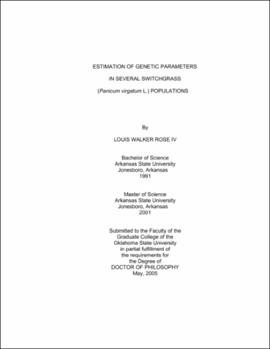| dc.contributor.advisor | Taliaferro, Charles M. | |
| dc.contributor.author | Rose, Louis Walker | |
| dc.date.accessioned | 2013-12-10T18:04:37Z | |
| dc.date.available | 2013-12-10T18:04:37Z | |
| dc.date.issued | 2005-05 | |
| dc.identifier.uri | https://hdl.handle.net/11244/7745 | |
| dc.description.abstract | Scope and Method of Study: The objectives of this study were to determine: 1) the effects of high- and low-biomass yield environments on plant selection in breeding switchgrass for enhanced biomass yield using recurrent selection, and 2) genetic variances, narrow-sense heritability (h2n), and predicted genetic gain (deltaG) from selection procedures for increased biomass yield in two populations (SL 93 & NL 94) of lowland ecotype switchgrass and two populations (SNU-EM & SNU-LM) of upland ecotype switchgrass. For objective 1, Co parent plants were selected for biomass yield based on performance of their half-sib (HS) progeny evaluated under high- and low-yield environments for 1 year. Yield performance of C1 HS families was assessed under both high-and low-biomass yield environments for 3 years. For objective 2, HS families and their clonal parent plants for the respective populations were evaluated in replicated field tests over 2 to 3 years. Genetic variance components for biomass yield were estimated for the respective populations and narrow-sense heritability (h2 n) estimates were derived using variance component estimates and by progeny-parent regression. | |
| dc.description.abstract | Findings and Conclusions: The results suggested that breeding gains may be higher when parent plant selection is based on HS progeny performance under a low yield environment. Significant magnitudes of genetic variation for biomass yield were found in the SL 93 and NL 94 populations, but not in the SNU-EM and SNU-LM populations. The h2n estimates varied in magnitude with population and method of calculation. Positive response to selection for higher biomass production was indicated in the NL 93 and NL 94 populations based on estimated magnitudes of genetic variation and h2n. Low amounts of genetic variation for biomass yield in the SNU-EM and SNU-LM populations predicted low, or no, response to selection, although some estimates of the additive genetic component of the available variation were of moderate to high magnitudes. | |
| dc.format | application/pdf | |
| dc.language | en_US | |
| dc.rights | Copyright is held by the author who has granted the Oklahoma State University Library the non-exclusive right to share this material in its institutional repository. Contact Digital Library Services at lib-dls@okstate.edu or 405-744-9161 for the permission policy on the use, reproduction or distribution of this material. | |
| dc.title | Estimation of genetic parameters in several switchgrass (Panicum virgatum L.) populations | |
| dc.contributor.committeeMember | Buchanan, David S. | |
| dc.contributor.committeeMember | Verhalen, Laval M. | |
| dc.contributor.committeeMember | Dashiell, Kenton E. | |
| osu.filename | RoseIV_okstate_0664D_1379 | |
| osu.accesstype | Open Access | |
| dc.type.genre | Dissertation | |
| dc.type.material | Text | |
| thesis.degree.discipline | Plant and Soil Sciences | |
| thesis.degree.grantor | Oklahoma State University | |
